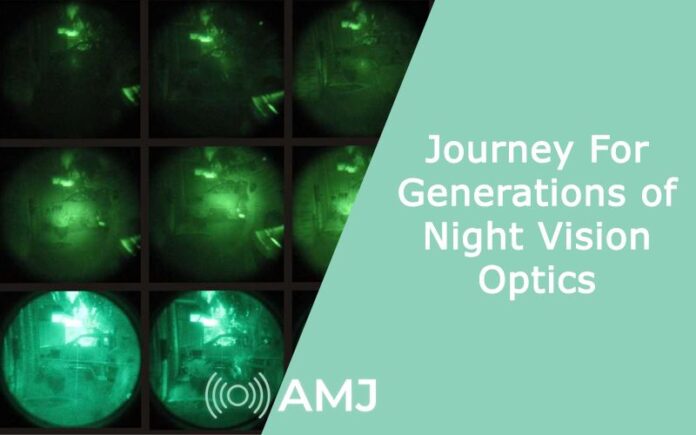The development of night vision technology has been a miracle of human ingenuity, enabling us to see beyond the constraints of our biology. This nighttime excursion represents a progression in our quest for perfect visibility of the invisible, not a single step. We are amazed at the advancements in this fascinating field as we investigate the various iterations of night vision optics.
Contents [hide]
- 1 First Generation: 1960s–1980s: The Beginning of Seeing in the Dark
- 2 Gen 2: Elevating Performance (1980s-1990s)
- 3 Generation 3: Superb Night Vision (from the 1990s onward)
- 4 Pushing the Boundaries: Generation 4+ (2000s-present)
- 5 Beyond Generations: New Technologies and Night Vision’s Future
- 6 How Night Vision Optics Work?
First Generation: 1960s–1980s: The Beginning of Seeing in the Dark
During the Cold War, the first generation of night vision devices, or “starlight scopes,” were created. These gadgets enabled low light levels by amplifying ambient light through the use of vacuum tubes and image intensifiers. Despite its crudeness, Gen 1 technology transformed the tracking of games by hunters and the navigation of soldiers.
Gen 2: Elevating Performance (1980s-1990s)
The night landscape became recognizable with the introduction of microchannel plate technology in Gen 2 night vision, which improved resolution and visual clarity. Additionally, it improved sensitivity, allowing users to see in a lower light, revolutionising night hunting for civilians as well as military and law enforcement purposes.
Strengths:
In comparison to Generation 1, the device has demonstrated notable gains in durability and dependability, as well as greater sensitivity resolution and image clarity.
Weakness: Artificial light can cause glare problems, while Gen 2 technology is more costly and prone to blooming and image distortion.
Generation 3: Superb Night Vision (from the 1990s onward)
With gallium arsenide photocathodes for improved clarity, resolution, and low-light sensitivity, Gen 3 night vision is an excellent image intensifier technology. In military and law enforcement applications, where having a clear vision is essential to success, it is very helpful.
Strengths: In addition to having great low-light sensitivity and image quality and resolution, the device is incredibly robust and dependable.
Weakness: Bright light exposure might cause irreversible damage to the most expensive generation.
Pushing the Boundaries: Generation 4+ (2000s-present)
Devices built for Generation 4 and later use cutting-edge technology including digital signal processing, unfilmed microchannel plates, and image intensifiers to enhance night vision. Enhancing nighttime operations and observation, these technologies promise crisper photos, better resolution, and near-infrared wavelength vision.
Strengths: The gadget is anticipated to have near-infrared wavelength vision capabilities, increase image clarity and sharpness, and possibly become lighter and more compact.
Weakness: The development process is hampered by limited availability and expensive cost, which emphasizes the necessity for additional technological breakthroughs.
Beyond Generations: New Technologies and Night Vision’s Future
With the introduction of new technologies like Enhanced Reality, Fusion Imaging, and Thermal Imaging, night vision is continuously changing. over the use of heat signature detection, thermal imaging allows users to see over barriers and in total darkness. Combining thermal and night vision photos, fusion imaging offers a thorough understanding of the surroundings. For object identification and tactical data, Enhanced Reality superimposes digital information on night vision photos.
How Night Vision Optics Work?
The slightest light, such as that from the moon, stars, or heat from objects, can be seen by night vision equipment, or NDVs. A microchannel plate multiplies and a phosphor screen amplifies the electrons released from light particles by the image intensifier tube, which has a photocathode built in.
By emitting green light at wavelengths conducive to night vision, the phosphor screen of the image intensifier minimises interference from external sources and improves detail and clarity in low light.
These days, night vision optics are employed in many different sectors, such as astronomy, hunting, wildlife photography, and search and rescue. Night vision is becoming more widely available because of technological and economic developments, opening up new avenues for the discovery of the night’s hidden treasures.












![Index of Money Heist [Season 1, 2, 3 & 4 – All Episodes, Cast and Plot] Index of Money Heist](https://www.asiamediajournal.com/wp-content/uploads/2021/05/Index-of-Money-Heist-3-100x70.jpg)